| Richie’s Verdict |
|---|
 The Asus ROG Strix Z690-E Gaming WiFi is a top-performing motherboard with plenty of fast USB ports and a PCIe 5.0 M.2 slot, making it a good choice for a DIY Gaming build. |
| Pros | Cons |
|---|---|
| ✅ Advanced overclocking features | ❌ Lacks extra PCIe x1 slot |
| ✅ Good connectivity | ❌ Expensive |
| ✅ Fast PCIe 5.0 M.2 slot | ❌ Single Ethernet port |
| ✅ Excellent audio |
Contents
The Asus ROG Strix Z690-E Gaming WiFi is an upper mid-range motherboard supporting Intel 12th generation Alder Lake CPUs. ASUS has improved upon the previous generation of Z590-E Gaming boards with increased power delivery (from 14 to 18 phase-count) to support more processor cores and PCIe 5.0, including a PCIe 5.0 M.2 slot. Currently, only Corsair offers a compatible M.2 SSD running on that spec, but more are sure to be available soon.
Other notable features include 12 USB rear ports, the latest Realtek audio codec, and a Slot Q-Release to make it easy to change a graphics card. ASUS has also improved the thermal design features to cope with all those extra cores from the Intel Alder Lake CPUs and the PCIe 5.0 M.2 slot.
Buy on Amazon via affiliate link: ASUS ROG Strix Z690-E Gaming WiFi
Asus ROG Strix Z690-E Gaming WiFi Specifications
Quick Specs
| CPU Support | Intel® Socket LGA1700 for 12th Gen Intel® Core™, Pentium® Gold and Celeron® Processors |
| Chipset | Intel® Z690 Chipset |
| Memory |
|
| Graphics |
|
| Expansion Slots |
|
| Storage |
|
| Network |
|
| Connectivity |
|
| Audio | ROG SupremeFX 7.1 Surround Sound High Definition Audio CODEC ALC4080 |
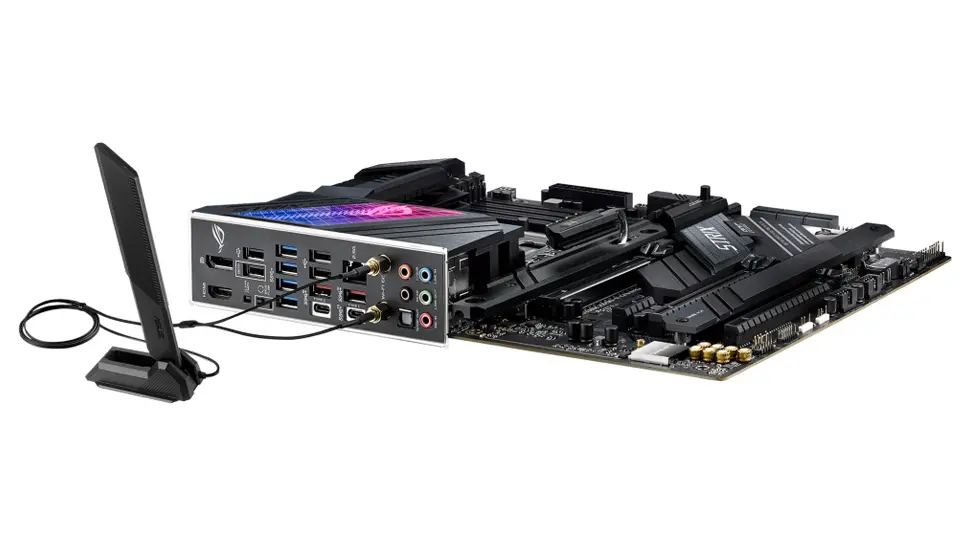
CPU Options
The ROG Strix Z690-E supports a wide range of Intel 12th Generation Alder Lake CPUs with an LGA1700 socket. It also supports Intel Turbo Boost 2.0 and Turbo Boost Max 3.0, depending on CPU choice. ASUS has increased the phase count from 14 to 18 to cater to the increased cores from Alder Lake CPUs and uses more durable capacitors.
ASUS uses 90 amp teamed VRMs (a total of 1620 amps); more than enough to handle the Intel Core i9-12900K CPU, even when overclocking. Choosing a quality, high-wattage PSU for this board is crucial for stability, whether you are overclocking or not.
When choosing a CPU for this board, your best bet is an Intel Alder Lake CPU with K, KS, F, or no-letter suffixes. Remember that CPUs with the F suffix requires a graphics card installed and will not support the onboard graphics options. The advantage of using an F-suffix CPU is that 100% of the cores are available for the system instead of graphics. Steer clear of E and T suffix CPUs used for embedded applications and power efficiency, respectively.
- K = Unlocked, ready for overclocking
- S = Special edition
- F = Requires a discreet graphics card
- E – Embedded applications
- T – Power efficient
Recommended CPUs
- High-end gaming/OC – Intel Core i9-12900KS or i9-12900KF
- Mid-range gaming/OC – Intel Core i7-12700K or i7-12700KF
- Budget gaming/OC – Intel Core i5-12600K or i5-12600KF
- Content Creator – Intel Core i9-12900, i9-12900K or i9-12900F
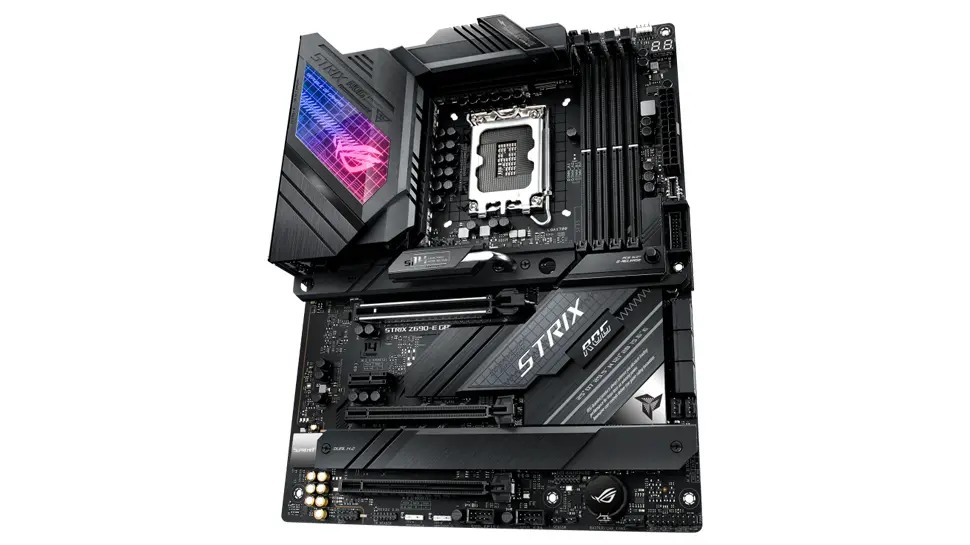
Memory Options
The ROG Strix Z690-E supports up to 128GB of DDR5 dual-channel memory with a native (non-overclocked) speed of 4800MHz and a fully overclocked speed of 6400MHz. It also supports Intel Extreme Memory Profile (XMP 3.0) and OptiMem technologies. Reaching the maximum 6400MHz RAM speed may not be possible as it will depend on memory quality, CAS timings, and BIOS settings.
It has four (4) memory channels available, so unless you are upgrading soon, be sure to fill each RAM slot to saturate the memory BUS. For example, if the total amount of memory you want is 64GB, buy 4× 16GB RAM modules to ensure the best performance.
I recommend a minimum of 32GB to get the best from this motherboard or 64GB if you can afford it. As for speed, you will pay a hefty premium for 6400MHz RAM, but for an experienced overclocker, that will not come as a surprise. If you are going down the 6400Mhz path, choose quality RAM from companies like Corsair, Giel, G.Skill, Team Group, and ADATA.
On-Board Graphics
The ROG Strix Z690-E offers excellent graphics options, including 8K@60Hz for the DisplayPort 1.4 and 4K@60Hz on the HDMI 2.1 port. Note that you will need to install a non-F suffix CPU to enable graphics.
These graphics are fine for Content Creators and budget gamers, but mid and high-end gamers will need at least one discreet graphics card installed.
I recommend mid, and high-end gamers install a CPU with the F suffix (F, KF) and use a discreet graphics card to enable 100% utilization of the CPU.
Storage Options
The ROG Strix Z690-E has an array of storage options, including a single PCIe 5.0 M.2 slot controlled by the 12th Gen CPU, two PCIe 4.0 ×4 M.2 slots, and six SATA 6Gbp/s ports. Intel Rapid Storage Technology supports NVMe RAID 0/1/5, SATA RAID 0/1/5/10, and Optane Memory. If you install a ROG Hyper M.2 card in an expansion slot, this will reduce the speed of other M.2 slots (aka PCIe bifurcation).
I think the best storage setup for this motherboard is to install a PCIe 5.0 NVMe M.2 card (1TB) into the M.2_1 slot (controlled by the CPU) for the system drive. Then two PCIe 4.0 ×4 NVMe M.2 drives (M.2_2, M.2_3) in a software RAID-1 array for a data drive.
I have never been a fan of software RAID due to my experiences with older mechanical SATA drives randomly dropping off the array. But nowadays, with SSD/NVMe, its become a viable option. Anecdotally, I ran two Samsung SATA SSDs on a RAID-0 array for my system drive for five years, and they did not miss a beat.
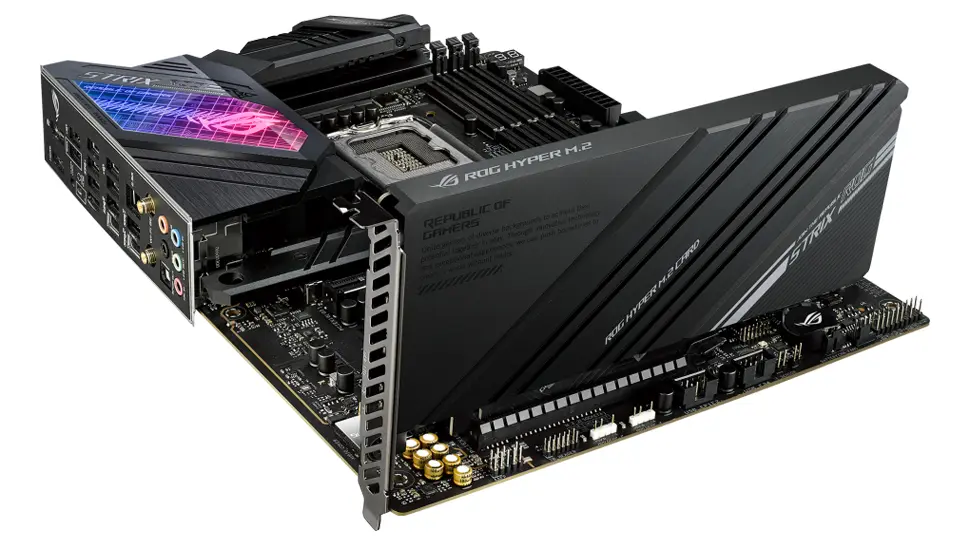
Expansion Slots
Expansion slots for this motherboard are good, although other motherboards in this class usually have an extra PCIe x1 slot.
There is a single PCIe 5.0 ×16 slot, one PCIe 4.0 ×16 slot, one PCIe 3.0 ×16 slot, and one PCIe 3.0 ×1 slot. The only issue is that if you use the PCIe 5.0 M.2 slot for an NVMe drive, the PCIe 5.0 ×16 slot will reduce and run in x8 mode, which is not ideal for a GPU. Instead, you would use the PCIe 4.0 ×16 slot for a GPU.
Networking & Connectivity
The ROG Strix Z690-E sports a 2.5Gb Ethernet port using an Intel I225 chip, with plenty enough speed for most users. But I am surprised this board does not have a dual LAN which could enable bonding and redundancy.
It has an Intel Killer WiFi 6E chip supporting 802.11 a/b/g/n/ac/ax and 2.4/5/6GHz frequency bands. It comes with a dual antenna and boasts transfer speeds of up to 2.4Gbps, so long as your WiFi router supports it. The AX1675 WiFi 6E chip also has Bluetooth 5.2, although BT 5.2 requires Windows 11.
It has plenty USB ports, including two USB 3.2 Gen 2 Type-C 2×2 ports (one rear, one front) with a transfer rate of 20Gbps.
- 1 x USB 3.2 Gen 2×2 Type-C port
- 2 x USB 3.2 Gen 2 Type-A ports
- 1 x USB 3.2 Gen 2 Type-C port
- 4 x USB 3.2 Gen 1 Type-A ports
- 4 x USB 2.0 ports
- 1 x USB 3.2 Gen 2×2 header
- 1 x USB 3.2 Gen 1 header
- 2 x USB 2.0 headers
Audio
Audio is excellent with a 7.1 channel High Definition Realtek ALC4080 chip marketed as ROG SupremeFX with a playback resolution between 192KHz to 384KHz across all channels. A Savitech amp powers the front panel output and will drive a wide range of high-fidelity headsets. It has gold-plated audio jacks and an Optical S/PDIF output jack.
BIOS & Overclocking
The UEFI BIOS features two modes of operation: EZ Mode and Advanced Mode. EZ Mode has overclocking presets, while Advanced Mode offers advanced settings like custom frequencies, voltage settings, etc.
The ROG UEFI BIOS features 5-way optimization that entails TPU Insight, EPU Guidance, Fan Xpert 4, DIGI+ Power Controls, and Turbo App. These built-in BIOS apps help you fine-tune your rig and get the most from your hardware.
ASUS has also embedded Memtest86 into the BIOS chip enabling you to test your RAM for faults; a handy feature to have as the alternative is to boot up a USB drive. Another handy feature is a BIOS Flashback button to restore your BIOS to default settings.
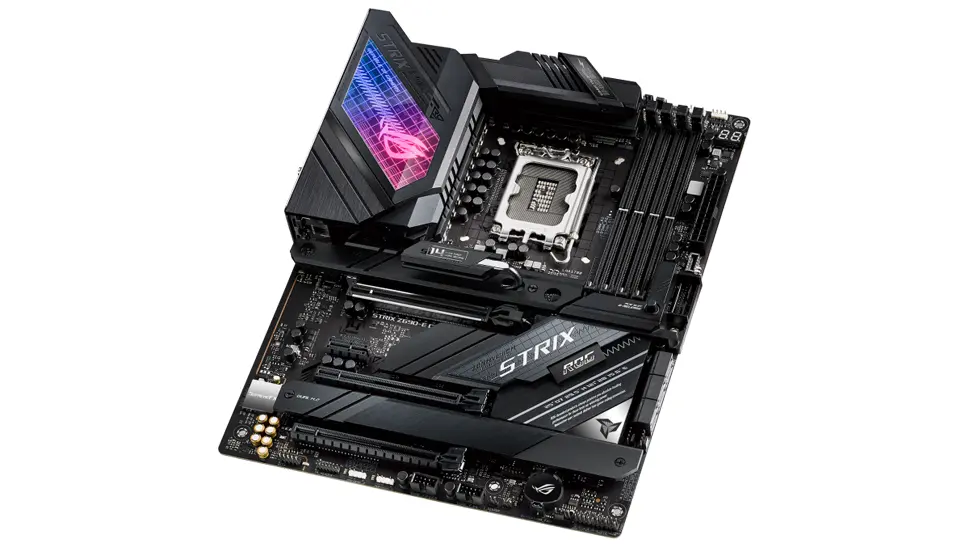
Other Features
Other features of the ROG Strix Z690-E are an AURA Sync RGB lighting control header, Q-LED diagnostic LEDs, ASUS Thermal Solution (heatsink backplate, M.2 heatsink), and many ASUS apps to control and optimize your rig. These include ROG CPU-Z, GameFirst VI, Sonic Studio III, Armory Crate, and DIGI-VRM, to name a few.
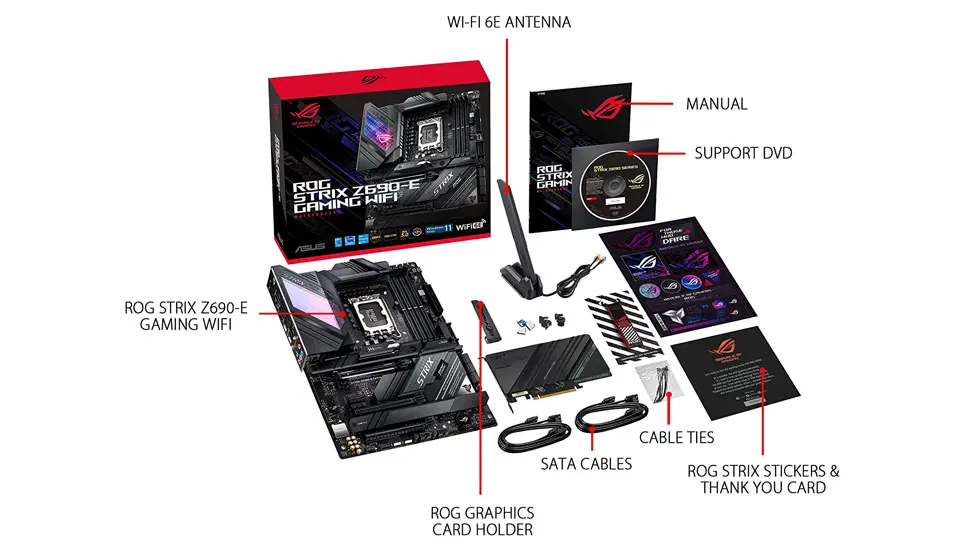
Conclusion
For an upper mid-range motherboard, the Asus ROG Strix Z690-E Gaming WiFi is top of its class, with a few negatives outweighed by the many positives. It is a good choice for a DIY Gaming build with expansive overclocking features, excellent audio, and good connectivity. Although PCIe 5.0 is in its infancy, it will become the norm soon, so it won’t be long before affordable PCIe 5.0 M.2 drives are available.
Buy on Amazon via affiliate link: ASUS ROG Strix Z690-E Gaming WiFi
See Also
- Alienware Aurora R14 Review – High Powered Performance
- SanDisk Extreme Portable SSD V2 Review – Fast and Tough
- TP-Link Archer AX21 Review – Best Value Wi-Fi 6 Router
- Samsung 32-inch Odyssey G5 Review – Best Budget Gaming Monitor

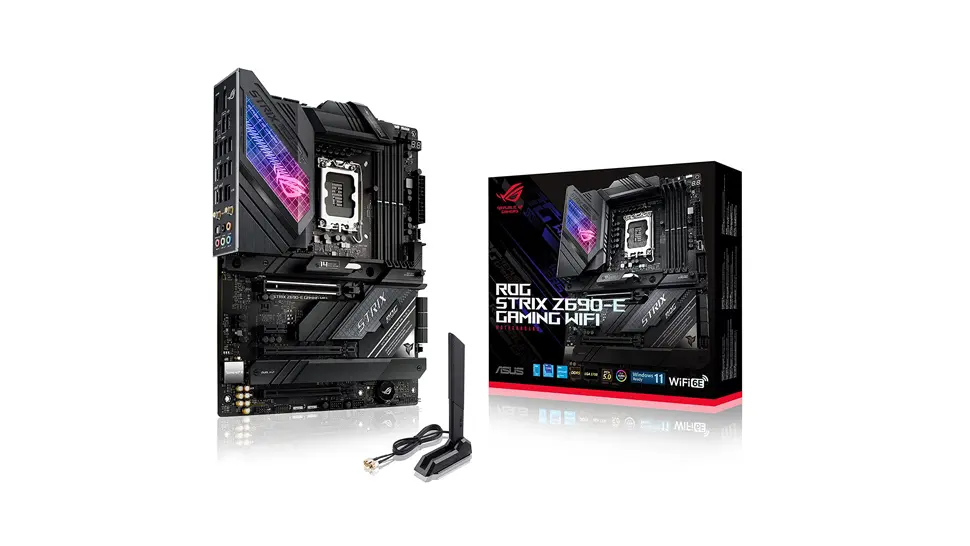
Comments
There are currently no comments on this article.
Comment